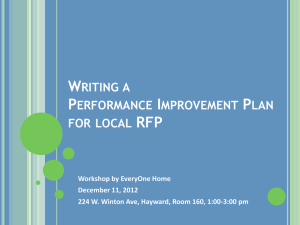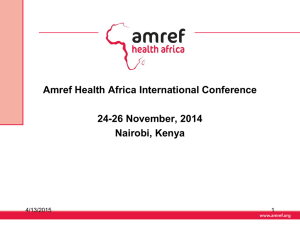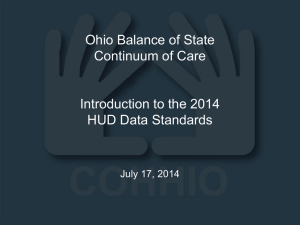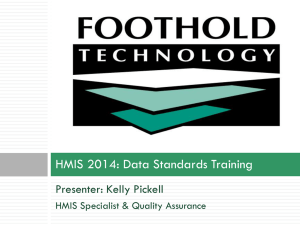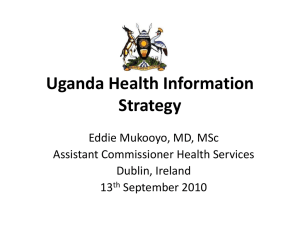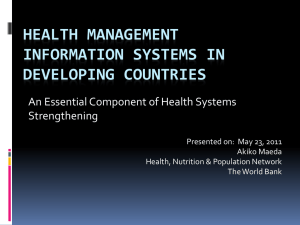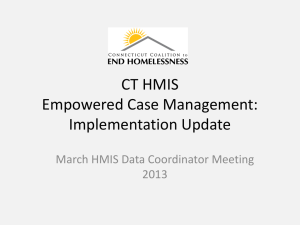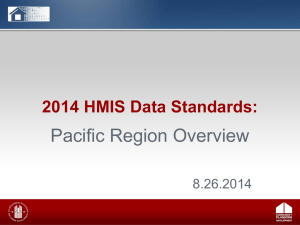DS_Awareness-presentation - Sacramento Steps Forward
advertisement
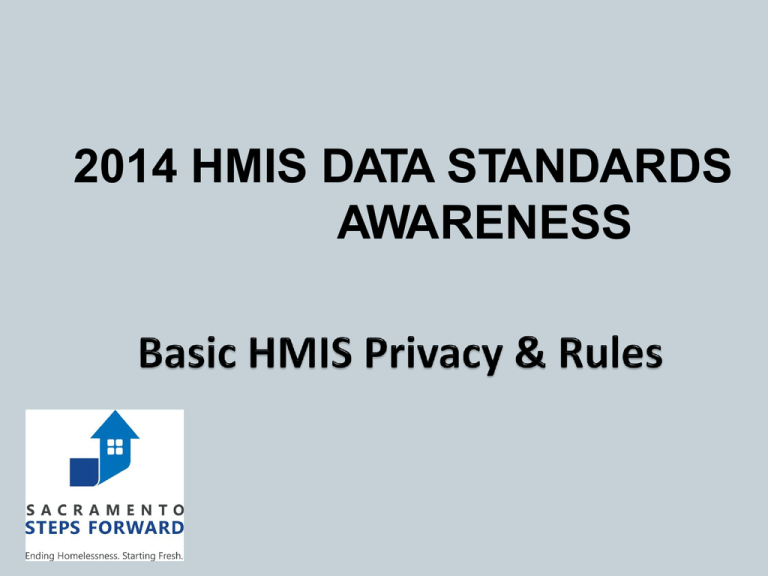
2014 HMIS DATA STANDARDS AWARENESS Agenda • Basic Privacy & Security Rules for HMIS • 2014 HMIS Data Standards • Overview of Key Changes Privacy • Defining Privacy: • Privacy refers to safeguarding of protected personal Information (PPI) in the HMIS from inappropriate use. • All information gathered and entered into the HMIS is considered PPI. • • • • Allows identification of an individual directly or indirectly; Can be manipulated by a reasonably foreseeable method to identify a specific individual; or Can be linked with other available information to identify a specific individual. Whenever this policy refers to personal information, it means PPI. Security Data security goes beyond your computer. HMIS Users, Agency, System Administers need to ensure that the PPI that is gathered and entered into the HMIS is secured at all times. Clarity System Security Features User passwords have minimum requirements Strong passwords are important Passwords expire every 90days Passwords can be alternated, meaning only two distinct passwords are necessary. Clarity System Admins do NOT know your passwords. HMIS USER Account inactivated after 90 days if not logged in HMIS User Responsibilities! • Take appropriate measures to prevent unauthorized data • • • • • • • • disclosure. Report any security violations. Comply with relevant policies and procedures. Input required data fields in a current and timely manner. Ensure a minimum standard of data quality by accurately answering all the HUD Universal Data Elements for every person entered into HMIS. Inform clients about the agency’s use of HMIS. Take responsibility for any actions undertaken with one’s username and password. Complete required training. Comply with HMIS User Agreement Security and privacy essentials NEVER share your username and password with anyone. NEVER share your password with HMIS System Administrators. NEVER rely on Post-It Note security Users take all reasonable means to keep their password physically secure Do not set your internet browser to save your Clarity password. Do not access Clarity on computers that do not have locking screens. Security and privacy essentials Contd… Users must understand that the only individuals who can view information in HMIS are authorized users and the clients to whom the information pertains. Users can only view, obtain, disclose, or use the database information that is necessary to perform their job, and which complies with clients’ signed permission to release information. Security and privacy essentials Contd… If a user is logged into the HMIS and must leave the work area where the computer is located, they must log-off of the software before leaving the work area. Users will not leave a computer unattended that has the HMIS software “open and running”. Users or the agency will keep hard copies of appropriate HMIS information/documentation in a secure place. All client information will be kept secure by ensuring that all hard copies of client forms are locked and secure when unattended. When hard copies of the HMIS information are no longer needed they will be archived for a minimum of seven years. Beyond that, hard copies of the records must be properly destroyed to maintain confidentiality. Security and privacy essentials Contd… If a user notices or suspects a security breach; they must immediately notify the Agency Administrator for HMIS or the System Administrator. Users will not knowingly enter false or misleading client information into HMIS under any circumstances. Data Security Agency Code of Ethics • The Agency will uphold relevant federal and state confidentiality regulations and laws that protect Client records and the Agency shall only release client records with written consent by the client, unless otherwise provided for in the regulations. • The Agency will ensure that all staff, volunteers and other persons who use HMIS attend appropriate training before receiving User ID and password to access HMIS Agency Code of Ethics Contd. The Agency will not knowingly enter false or misleading data under any circumstances. If a Client withdraws consent for release of information, the Agency remains responsible to ensure that the Client’s information is made private in HMIS The Agency agrees not to release any confidential information received from the database to any organization or individual without proper Client Consent Basic Privacy Rules Consumer Notice: All participating agencies must post a Consumer Notice in a conspicuous area to inform clients of participation in HMIS System Privacy Notice: A notice detailing all privacy protections should be made available to clients upon request. It should be posted on the Agency Website if one exists. Agency will not collect or share information unless it is essential to providing services, program management, as part of approved research, or as required by law. Written Informed Consent • • At entry into the program, the Case Managers/Intake Workers are required to review and have client sign the “Informed Consent Release form. The client will complete, sign and date the HMIS consent. Agency will not divulge confidential information without informed client consent.”. • • • • • If client doesn’t sign, then their PPI and other information should not be entered into the system. Could be entered w/o PPI In some cases additional consent may be required! Clients cannot be denied services that they would otherwise qualify for based on a refusal to share information. Must be renewed every 5 years Hardcopy must be retained in client file for at least five years upon clients exits program When in Doubt! Use your Resources! Contact Manjit Kaur 916-993-7703 Email: mkaur@sacstepsforward.org HMIS Data Standards • HMIS Data Dictionary • Provides data element basics and instructions for HMIS software provider • https://www.hudexchange.info/resources/documents/HMIS-Data-StandardsManual.pdf • HMIS Data Manual • Includes explanations and definitions for HMIS administrators, CoCs, and HMIS users https://www.hudexchange.info/resources/documents/HMIS-Data-Dictionary.pd • Program Manuals • Federal partners will issue guidance related to data elements required for their programs for HMIS administrators, CoCs, and HMIS users Revision Process • The HMIS Data Standards were revised to: – Comply with The HEARTH Act – Include feedback received from: • • • • • • Individuals (>2k public comments) and CoCs HMIS Implementations (vendors /software providers) The National Human Services Data Consortium (NHSDC) U.S. Dept. of Health and Human Services (HHS) U.S. Dept. of Veteran Affairs (VA) HUD’s Office of HIV/AIDS Housing – Streamline reporting and clarify data requirements • NOTE: Every field should meet a need! The Sacramento CoC submitted participated in the NHSDC comments Timeline to be decided HUD • Updated programming specifications for the current APR to cover transition period • A revised APR will go into effect after a full year of data collection under the new standards • Crosswalks between 2010 data and 2014 standards documentation) • Revised AHAR for 2015 Vendor • Revised import/export specifications (.csv file Timeline to be decided Contd… In the coming months, HUD and its federal partners (HHS and VA) will release the following guidance and information: • • • • • The HMIS Program Descriptor Data Element (PDDE) Manual Program-Specific HMIS Manuals: detailed, program-specific guidance for each program required to use HMIS (e.g. CoC, ESG, HOPWA, etc.) HMIS Notices for Public Comment: HMIS Governance, HMIS Privacy and Security, and HMIS Software and Data Quality Training Tools for the 2014 Data Standards: including a glossary, detailed crosswalk between 2010 and 2014 data standards Final HMIS Rule Implementation Day10/1/2014 • HMIS software updates live • Projects collect and enter client data consistent with revised data standards Overview of Key Changes- Language - Program vs. Project Federal Programs CoC ESG SSVF Recipient Recipient Continuum Projects • Subrecipient(s) Grantee Recipient • Subrecipient(s) • Program Name and Program Entry Date are now Project Name and Project Entry Date • Category of Program-Specific Data Elements hasn’t changed; each element is relevant for one or more federal programs / funding streams Structural Changes 2010 Data Element Groups 2014 Data Element Groups • Program Descriptor • Project Descriptor • Universal • Universal • Program-Specific • Program-Specific (Data • Optional Elements hasn't changed; each element is relevant for one or more federal programs/funding streams • Metadata Metadata • A series of metadata elements were also adopted in the 2014 standards. • Rather than capturing information about a project or client, metadata describes information about the data itself: • when it was collected, when it was entered into HMIS, who entered it, and which project is responsible for it. These elements are intended to facilitate reporting from HMIS, simplify programming, and provide an audit trail. Overview of Key Changes Project Type Codes Services Projects Lodging Projects Emergency Shelter Safe Haven Transitional Housing Rapid Re-Housing Permanent Supportive Housing Permanent Housing with Services Permanent Housing: Housing Only Coordinated Assessment Homelessness Prevention Street Outreach Day Shelter Services Only Other * More Details On page 7 in the 2014 HMIS Data Standards Manual Universal Data Elements (UDE) • 3.1 Name • 3.11 Project Exit Date • 3.2 Social Security Number • 3.12 Destination • 3.3 Date of Birth • 3.13 Personal ID • 3.4 Race • 3.14 Household ID • 3.5 Ethnicity • 3.15 Relationship to Head • 3.6 Gender of Household • 3.16 Client Location • 3.17 Length of Time on Street, in an ES or Safe Haven • 3.7 Veteran Status • 3.8 Disabling Condition • 3.9 Residence Prior to Project Entry • 3.10 Project Entry Date Overview of Key Changes Name Quality has been Added (NEW) Name Data Quality – Full name reported – Partial, street name, or code name reported – Client doesn’t know – Client refused – Data not collected Overview of Key Changes New UDE • Client Location – Identifies the location of each client by Continuum of Care code – Corresponds to CoC Code project descriptor – HMIS may auto-populate values for projects that operate in only one continuum Overview of Key Changes • ‘Transgendered’ categories has became ‘Transgender’ • Veteran Status collected once per client rather than at every project entry • Disabling Condition collected for adults only Overview of Key Changes New UDE • Relationship to Head of Household • One HoH per enrollment • HoH may be thought of as ‘household representative,’ ‘primary client,’ ‘eligible individual,’ etc. • Unaccomplined Youth with child or self will be considered Head of the Household • All Adult intake, status assessment, & exit questions will apply. • CoC must establish guidelines for identifying the HoH where a funder hasn’t provided specific guidance • Serves as basis for a standardized method (APR and AHAR) to count households over time New Universal Data Elements to Determine Chronic Homelessness New UDE • Length of Time on Street, in an Emergency Shelter, or Safe Haven • Client’s history of homelessness, disability status, • Enables identification of chronically homeless persons in an HMIS (in combination with other data) Overview of Key Changes • Other Slight changes in 2014 Data Standards • Destination (at exit) was moved from a Program Specific to a Universal Data Element Universal Data Elements (UDE) UDE are elements required to be collected by all projects participating in HMIS, regardless of funding source. UDEs establish the baseline data collection requirements for all contributing CoC projects. UDE are the foundation on which the Annual Homeless Assessment Report (AHAR) is developed Data Collection Summary Staged of HMIS Data Collection • Collection Points • • • • • Record Creation Project Entry Update Annual Assessment Project Exit “Data Not Collected” Has been added as a response to most data element It is not a response option necessary in every system or in every element. However, the element is required for use by any HMIS system which requires a response to an element before allowing the user to move forward in the system. Adding the response option of “data not collected” enables a user who did not collect or simply does not have the information to enter a response that does not present a false answer. Data Value for this response is considered “Data Missing” Changes to Existing response categories! “Don’t know” and “Refused” responses have been revised to read “Client Doesn’t Know” and “Client Refused” to clarify that this response should only be chosen only when the client has been asked and does not know the answer. Disabling Condition Status • Disabling Condition • Record whether the client has a disabling condition based on one or more of the following: • A physical, mental, or emotional impairment, including an impairment caused by alcohol or drug abuse, post-traumatic stress disorder, or brain injury that: • (1) Is expected to be long-continuing or of indefinite duration; • (2) Substantially impedes the individual's ability to live independently; and • (3) Could be improved by the provision of more suitable housing conditions. • A developmental disability, as defined in section 102 of the Developmental Disabilities Assistance and Bill of Rights Act of 2000 (42 U.S.C. 15002); or • The disease of acquired immunodeficiency syndrome (AIDS) or any condition arising from the etiologic agency for acquired immunodeficiency syndrome (HIV). • Additionally for veterans note: if the client is a veteran who is disabled by an injury or illness that was incurred or aggravated during active military service and whose disability meets the disability definition defined in Section 223 of the social security act. Program Specific Data Elements (PSDE) Housing Status 4.12 Contact 4.2 Income and Sources 4.13 Date of Engagement 4.3 Non-Cash Benefits 4.14 Services Provided 4.4 Health Insurance 4.15 Financial Assistance 4.5 Physical Disability 4.6 Developmental Disability 4.7 Chronic Health Condition 4.8 HIV/AIDS 4.9 Mental Health Problem 4.10 Substance Abuse 4.11 Domestic Violence Provided 4.16 Referrals Provided 4.17 Residential Move-In Date 4.18 Housing Assessment Disposition 4.19 Housing Assessment at Exit Program Specific Data Elements Program Specific Data Elements differ from the Universal Data Elements in that no one project must collect every single element in this section. Which data elements are required is dictated by the reporting requirements set forth by each Federal partner for each of their programs. Overview of Key Changes- Program-Specific Major Changes • Housing Status • Revised to align with federal homeless, at-risk Definitions • Required for All Clients • Income & Sources, Non-Cash Benefits • HoH and adults only • No longer required for accompanied children • Record only current sources vs. all for last 30 days • New Health Insurance data element was added • Required for All Clients Other Changes Residence Prior to Project Entry • • • HoH and adults only No longer required for accompanied children Changes and new response categories added • See Intake Form • Destination • • • HoH and adults only No longer required for accompanied children Changes and new response categories added • • The federal partners have added “no exit interview conducted” as a potential response, but this answer will be considered null/void in a data quality report. Other added categories (see intake form) Information Date • Information Date for data collected at project entry / exit must match entry / exit date • Information Date for annual assessments must be ±30 days of the anniversary of project entry • Responses must be accurate as of the Information Date, regardless of when data are collected Questions? Use your Resources! Contact Manjit Kaur 916-993-7703 Email: mkaur@sacstepsforward.org
